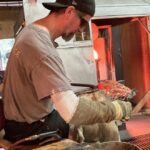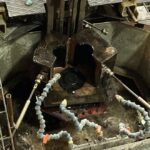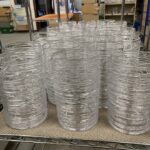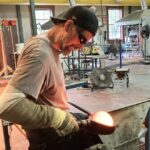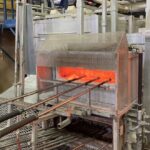Simon Pearce is a famous glass making company located in Windsor, Vermont. The company is named after its founder, Simon Pearce (born 1946), an Irish-American entrepreneur in glassblowing and pottery. Before opening his first US factory, in Quechee, Vermont, in 1981, Pearce learned his trade in Kilkenny, Ireland. The factory in Vermont is powered hydroelectrically by the Ottauquechee River and visitors are welcome to browse the showroom, dine at the restaurant, and tour the glass-blowing demonstration facility. The New York Times reports Pearce to be a prominent American designer of glassware and his works have been given as gifts to foreign dignitaries and to presenters at the Academy Awards.
In this video, Mark Williams, master glassblower with Simon Pearce, demonstrates production of an Echo Lake Hurricane candle holder.
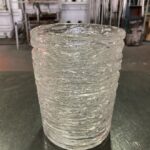 The Simon Pearce catalog describes this piece: “In a bold interpretation of the craft, master glassblowers nimbly wrap fine strands of glass around a cylindrical base to form the unique, natural silhouette of each candle holder. Whether frozen in winter, or flowing in summer – this piece was inspired by the constantly changing rivers, streams and waterways in Vermont.”
The Simon Pearce catalog describes this piece: “In a bold interpretation of the craft, master glassblowers nimbly wrap fine strands of glass around a cylindrical base to form the unique, natural silhouette of each candle holder. Whether frozen in winter, or flowing in summer – this piece was inspired by the constantly changing rivers, streams and waterways in Vermont.”
In our next video, Jeff Pellerin, master glassblower with Simon Pearce, demonstrates the technique for making a 6″ Vermont Evergreen.
These glass trees are available in a variety of sizes and used frequently for holiday decorations. Here’s a gallery of a few more pictures from the glass factory:
Now that you’ve had a chance to see the work of master glassblowers, it’s time to do an activity yourself.
Activity #1 – Sugar Glass
In this first activity, the Sci Guys show us how to make Sugar Glass, explain the chemistry behind the different ingredients, and discuss the importance of the temperature of the solution.
Activity #2 – Sugar Bowls
In this 2 part video, from How To Cook That, we learn how to make sugar bowls. This activity also demonstrates the thermal conductivity of water. When filling your water balloons, we strongly recommend following Ann Reardon’s advice making sure all air has been removed and do not completely fill the balloons. We recommend watching her second video in its entirety before attempting to make your own sugar bowls. There are additional sugar creations on her website https://www.howtocookthat.net/public_html/ that you may be interested in once you complete this activity.
Activity #3 – Isomalt Glass (a sugar substitute)
In this final activity, watch Chef Natalia Rudakova demonstrate how to recreate one of the famous Spanish, Pastry Chef Jordi Roca’s desserts at home.
- In your opinion, what was the most interesting part of the glass blowing demonstrations?
- In your opinion, which activity did you find most interesting?
- If you tried one of the activities, which one(s)? Please upload pictures of your finished creation(s)?
Earn badges and qualify for prize drawing by registering and answering journal questions. It's fun and easy!


